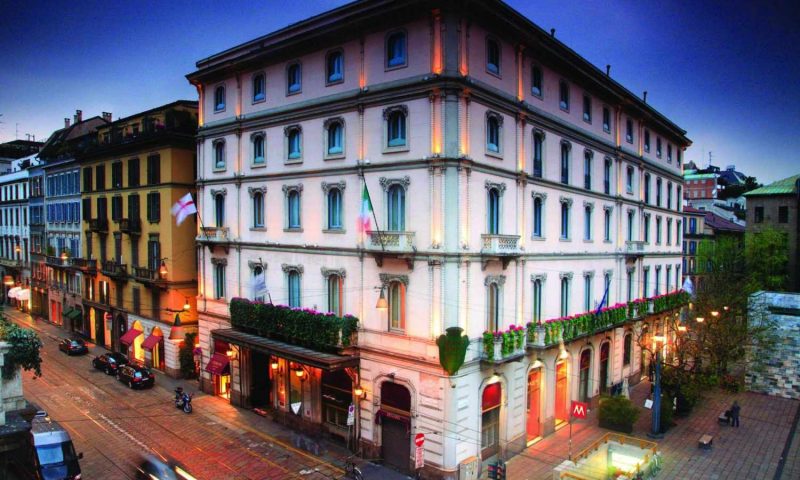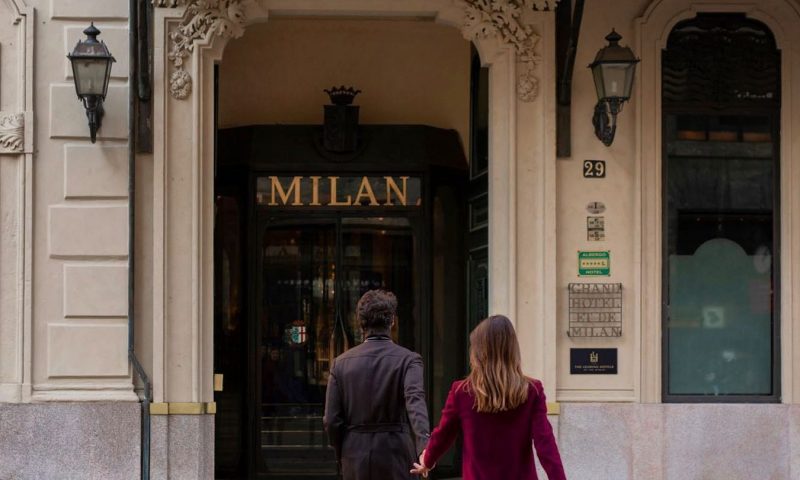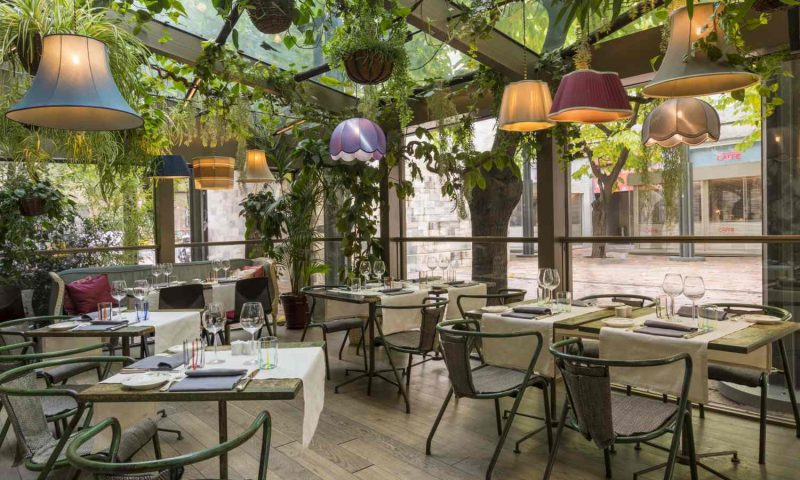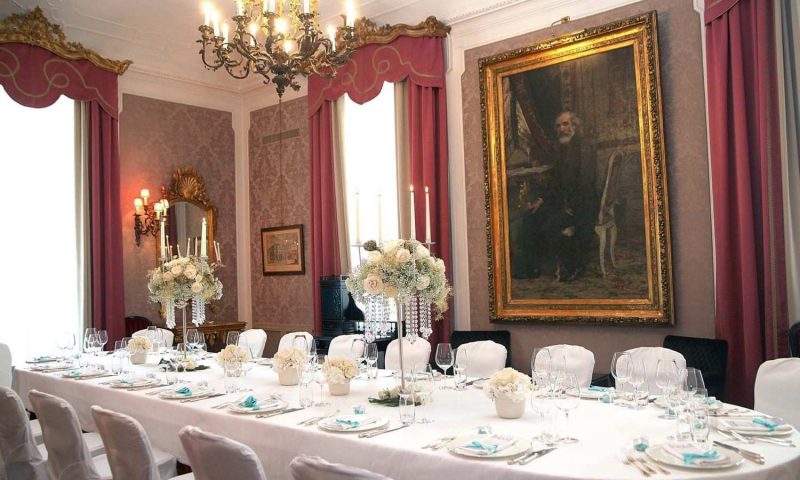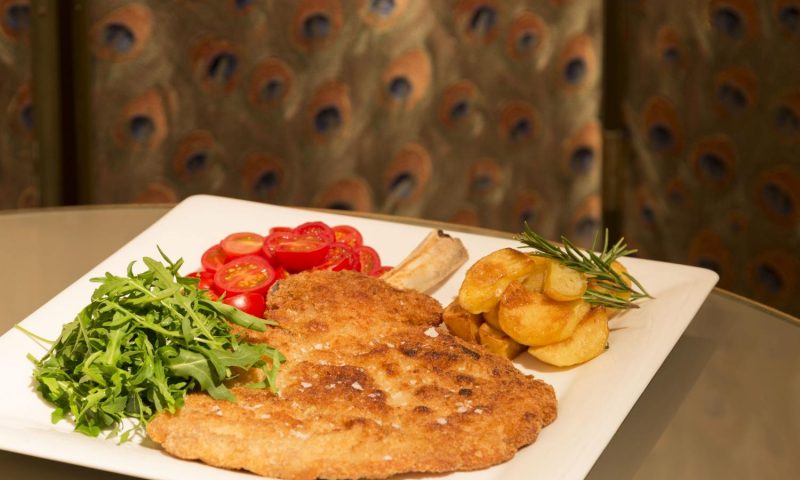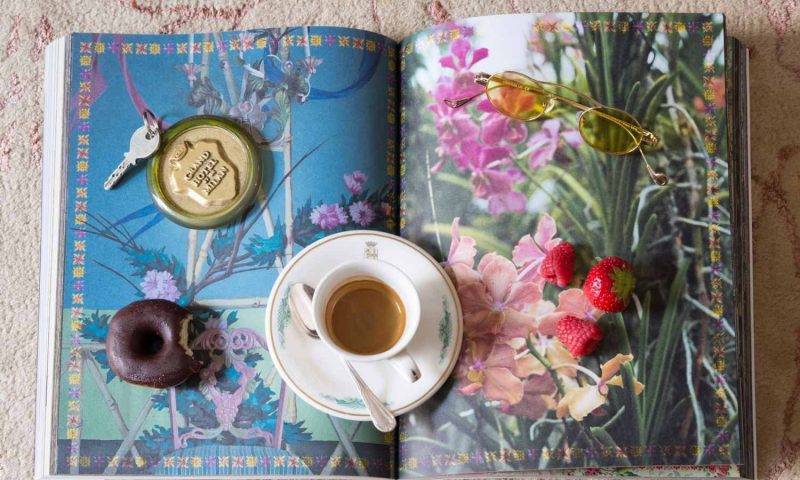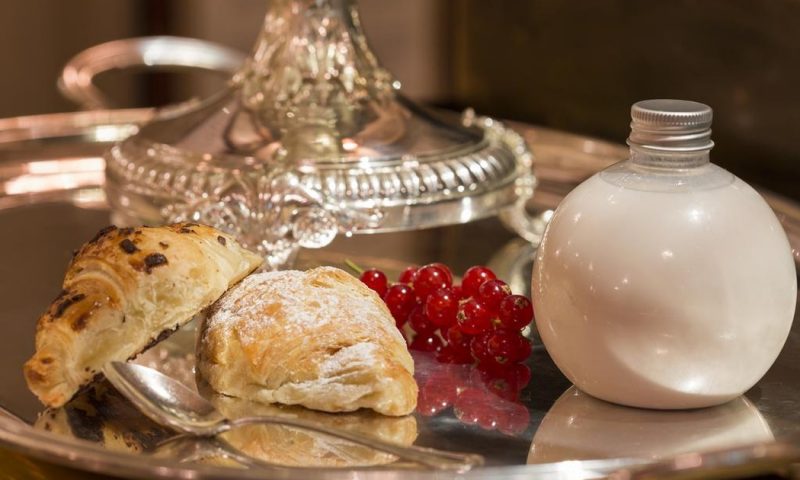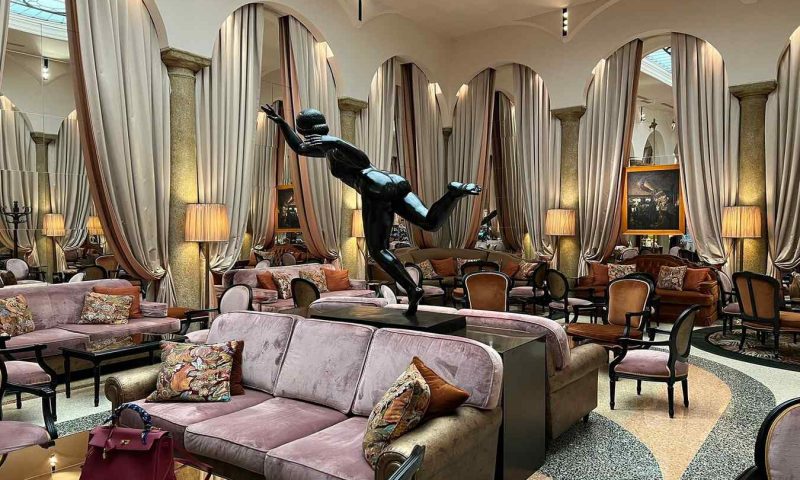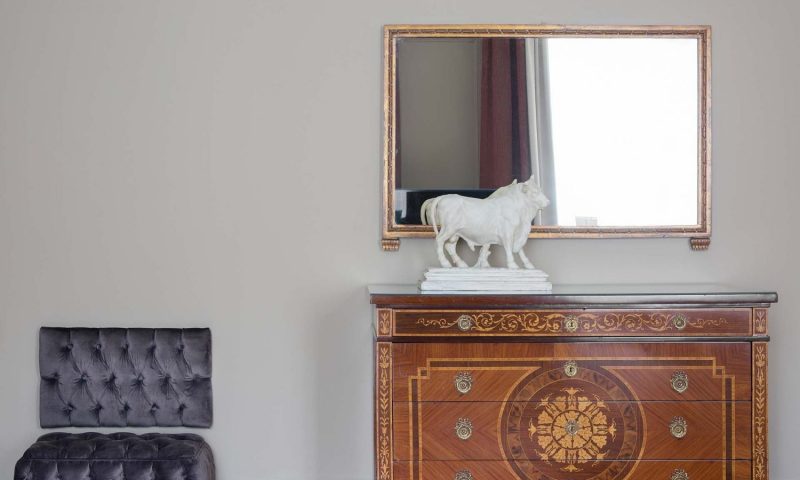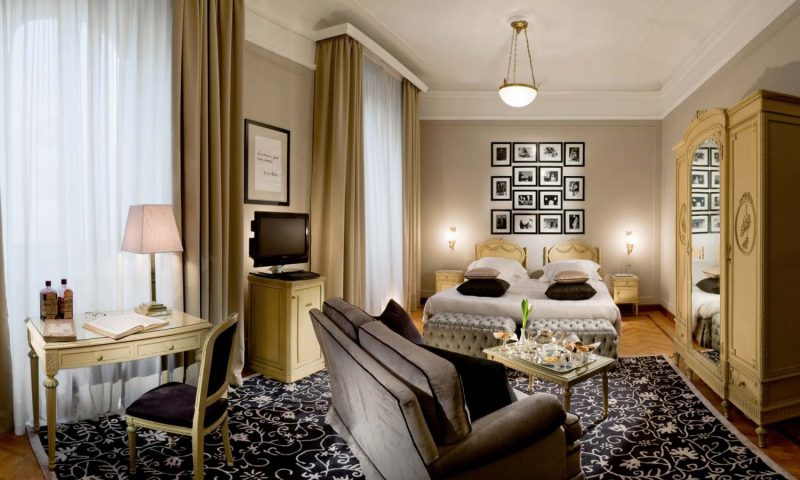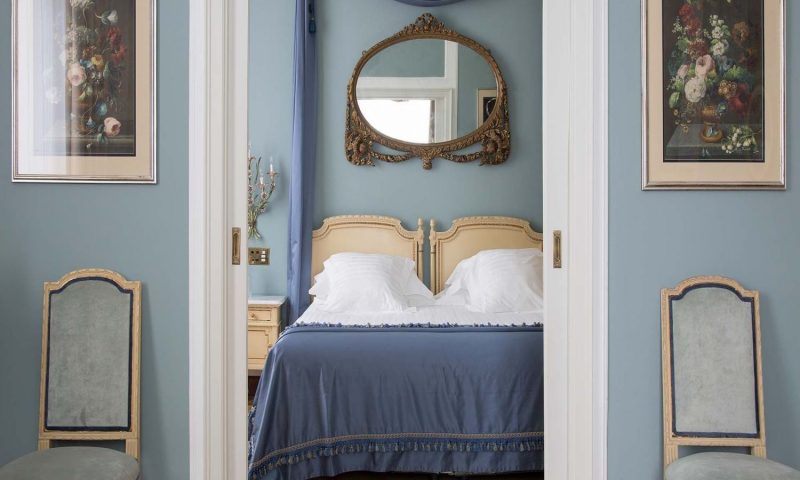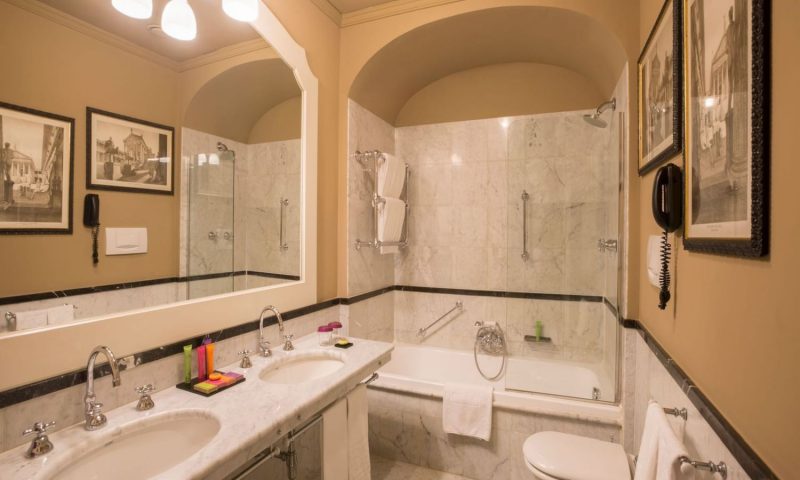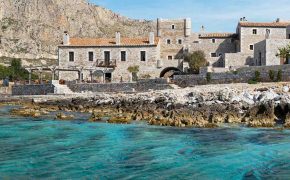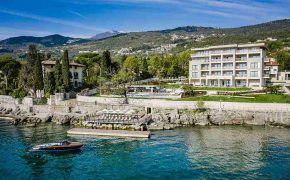A place rich in atmosphere, full of traces left by the passage of great personalities whose names have shaped the history. Opened in 1863, the Grand Hotel et de Milan preserves all the charm of an ancient Milanese “house”. It is still nowadays the favourite hotel of eminent names of the world of culture, entertainment, fashion, music, national and international business.
Every single detail has been conceived paying particular attention to the environment and the chromatic dominant in which is set, linked to the latter with harmonious or in contrast elements. The project is permeated by a great passion for history, shared both by the owners and the management, as well as by Dimore Studio.
Don Carlos, Gerry’s Bar, Caruso Restaurant with its Veranda and open air Dehors, where tradition and innovation come together to satisfy the most demanding tastes!
Verdi, Puccini, Giordano: three well-lit lounges combining a unique atmosphere with state-of-the-heart technology for the organization of events, business meetings, receptions, banquets and exhibitions. Besides the rooms available for private events, the Grand Hotel et de Milan boasts two restaurants, the Caruso and the Don Carlos.
IN THE HEART OF MILAN
Occupying an enviable spot in the heart of the city center, just a few steps from the financial district, the Teatro Alla Scala, the Fashion District and the Duomo Cathedral, the Grand Hotel et de Milan with its bar and restaurants, gourmand enclaves of the city, is the perfect place to stay, whether for pleasure or for business.
Point of reference for guests looking for luxury, discretion and privacy, set in the cosy and pleasantly vintage atmosphere of an aristocratic historical Milanese palace. Since three generations, the management of the hotel has been passed on to the Bertazzoni Family, who runs it with great passion.
Among the many distinguished guests staying here in the past, the Maestro Giuseppe Verdi chose the “Milan” for many years: since then, the love for music and the Opera has permeated its rooms as a sublime leit motiv.
THE VERDI SUITE
The Suite comprises a wide and well-lit living room with original period chimney and furniture, a bedroom and two bathrooms. The lounge has been recently restored and it is today more sophisticated than ever.
The bedroom and the sitting room can be reserved separately and the Verdi room can be turned into a wonderful period setting, perfect for a stay, receptions and business meetings in a refined and timeless atmosphere.
The Grand Hotel et de Milan’s Presidential Suite is dedicated to the Maestro Giuseppe Verdi. The Maestro chose the Suite 105 of the once called “ Albergo di Milano”, to alternate the hustle and bustle of the city to the quieter and relaxing life of his country house of Sant’Agata.
In those years, the Maestro was working at the Othello and on the occasion of his first performance, cheered by the adoring crowd, Verdi went onto the balcony of his apartment with the tenor Tamagno to sing some arias of the opera.
The people of Milan shown the same veneration when, some years later, they asked the Director of the Hotel to affix notes regarding the Maestro’s critical health conditions that ultimately led Verdi to his death on January 27th, 1901
DEDICATED SUITES
The passage of distinguished guests, who have chosen the Grand Hotel et de Milan throughout the years as their “Milanese house”, is celebrated by the dedicated suites.
Each of them is characterized by a selection of objects, photos, autographic documents and other memories, belonged to the personage or ascribable to his/her life. Giuseppe Verdi, Gabriele D’Annunzio, Maria Callas, Giorgio Strehler, Enrico Caruso are only some of the personalities to whom the hotel’s Suites and Junior Suites have been named after.
ENRICO CARUSO SUITE
Among the many anecdotes that link the Grand Hotel et de Milan to the great figures of Italian Opera, one concerns the tenor Enrico Caruso, to whom Junior Suite 306 is dedicated. The tenor was in Milan to sing at La Scala under Arturo Toscanini direction.
In the same period, Fred Gaisberg, a pioneer of phonographic recording at the Voce del Padrone record company, asked the tenor to record some opera arias from “Germania” and Caruso had a sort of recording studio set up in his hotel: it was here that the first flat matrix record in the history of music was realized.
Gaisberg was so enthusiastic about Caruso’s voice that, despite the record company’s refusal to pay the exorbitant sum of one hundred pounds requested by the tenor, he paid out of his own pocket in order to record his voice.
ROOMS & SUITES
The interiors of the Grand Hotel et de Milan, discreet and refined, conquer with the unique atmosphere of its rooms, enriched over the years with exclusive objects and furniture that are now part of its history.
The rooms perfectly preserve the period furniture and details, as well as the parquet floors and the Italian marbles that decorate the spacious bathrooms. Seventy-two rooms and twenty-three suites offer a variety of accommodations.
The recent renovation, entrusted to Studio Dimore of Milan, has enriched the various environments with light contemporary touches, while maintaining the allure intact, with an intervention focused on fabrics, carpets, colours and decorations.
Every single detail has been conceived paying particular attention to the environment and the chromatic dominant in which is set, linked to the latter with harmonious or in contrast elements.
The project is permeated by a great passion for history, shared both by the owners and the management, as well as by Dimore Studio: objects and furniture have maintained the precious patina gained throughout the years and the desire of bringing new life to the endless number of period pieces and historic references is a tangible endeavor and the great treasure of the Grand Hotel et de Milan.
Each room is equipped with air conditioning and central heating, minibar, flat-screen television, radio, security box, spacious marble bathrooms with en-suite telephone, exclusive toiletries and cosmetics by Etro, 24-hour room service.
RESTAURANT “CARUSO”
The Caruso restaurant, with its pleasant “jardin d’hiver”, offers a cuisine that reinterprets traditional Milanese dishes in a contemporary key. Inside the delightful Veranda set in the green environment of the small square, period furniture cohabits with contemporary elements, creating a timeless atmosphere that recalls the one of the Parisian bistrot.
At the beginning of 2011, the inside hall of the restaurant was renovated, leaving anyway untouched the internal structure organized on two levels, the big Corinthian columns with decorated capitals and the two precious Murano chandeliers dating back to the 1920s.
GERRY’S BAR
A discreet, private and sophisticated lounge in the heart of Milan. Perfect for a cup of tea, an aperitif, light bites throughout the day, it becomes, together with its American bar, an after-theatre place open until late in the evening.
Recently refurbished, it maintains its fine décor, while sacrificing nothing of its unique atmosphere, the place to be in the hustle and bustle of the city. A oasis of tranquility, the ideal location for business appointments far from the chaotic noise of the city.
DON CARLOS RESTAURANT
The Don Carlos pays tribute to the Maestro Giuseppe Verdi, who stayed at the Grand Hotel et de Milan for more than twenty years. In an intimate and refined setting, re-created by paintings, sketches and scene-paintings from Teatro Alla Scala’s museum, the Don Carlos proposes Italian traditional cuisine, revisited by our Chef under the light of its antique silver chandeliers.
Our Chef interprets with creativity and refinement simple menus taken from the flavours and fragrances of the Milanese tradition. A traditional cuisine respectful of the seasonality of each ingredient.
MEETINGS & EVENTS
Verdi, Puccini, Giordano: three well-lit lounges combining a unique atmosphere with state-of-the-heart technology for the organization of events, business meetings, receptions, banquets and exhibitions. Besides the rooms available for private events, the Grand Hotel et de Milan boasts two restaurants, the Caruso and the Don Carlos.
WEDDINGS IN MILAN
Choosing the Grand Hotel et de Milan for your event means indulging in a stunning vintage setting, decorated with frescoes, paintings from the collection of Marie Louise of Austria and period furniture, in an aristocratic nineteenth century palace.
A wedding at the Grand Hotel et de Milan becomes your unique event thanks to our in-depth understanding of how to stage an exclusive and unforgettable occasion and a memorable day for you and your guests, who will be welcomed amid luxury, high-class surroundings.
Located in the heart of the Milanese city centre, just a stone’s throw from Via Montenapoleone, the Teatro Alla Scala and the city’s must-see sights, our wedding hotel in Milan offers the most romantic and prestigious location for weddings, celebrations and parties.
Our rooms allow us to organise events for a few close friends or seated banquets for up to 150 guests. Finally yet importantly, partygoers and guests of honour will also have the opportunity to continue enjoying themselves into the night, or, why not, to stay for an enjoyable holiday.
FITNESS
The fitness room is located on the second floor in a large terrace completely surrounded by the green, with floor-to-ceiling windows overlooking the internal courtyard.
A bright and perfect place to relax after a hard day’s work or shopping. A personal trainer is available upon request, along with a massage service provided in the privacy of your own room and one to one yoga sessions.
THE HISTORY
The project was entrusted to the architect Andrea Pizzala, an acclaimed professional, known above all for having created the Galleria De Cristoforis here in Milan in 1831. The building was smaller with respect to the current one. A palace with an eclectic style, whose façade and ornaments present many decorative references to the neo-gothic repertoire.
These architectural references were inspired by works published in those years, and influenced by the English Romantic Movement: what is commonly referred to as the “Gothic Revival”. Towards the end of the 19th century, the Hotel acquired significant importance, as it was the only one in the city furnished with postal and telegraph services.
For this reason, the Hotel was often attended by diplomats and businessmen. The Hotel featured approximately two hundred rooms, a “Stigler” hydraulic system lift (recovered during the recent renovation work and still currently in use), a little Winter garden and lavishly furnished dining rooms.
THE PRESTIGIOUS GUESTS
The Hotel has always listed names of national and international renowned amongst its guests. The most illustrious of these was the Maestro Giuseppe Verdi, who stayed here from 1872, alternating his business life in the city with the relaxing environment of his country home in Sant’Agata. In those years, Verdi spent a long time working on “Othello” and then “Falstaff”.
At that time, the Countess was distraught by the death of her only daughter and resumed her social life only after the launch of a cultural salon in her house, where influential figures as Manzoni, Cattaneo, Correnti, Manara, Balzac and Rossini used to gather and discuss of a variety of topics, related to the current social, cultural and political context.
It was in the Countess’ salon that Verdi, tormented by the death of his wife and children, found the new inspiration leading him to his “Nabucco” triumph. After forty years of absence and fifteen of silence, on February 5th, 1887, Verdi came back to the stage of La Scala with “Othello”. It was an unforgettable day.
The city was already buzzing in the early afternoon. On that winter day, everyone was in the streets: barrel-organs played Verdi tunes and everywhere people shouted “Long live V.E.R.D.I. !”, a slogan with a double meaning: not only did it cheer on the Maestro, but the exclamation also stood for “Viva Vittorio Emanuele Re d’Italia” (Long Live Vittorio Emanuele King of Italy).
As it was customary use for triumphant theatricals, after the first “Othello” performance, the carriage that was taking Verdi back to the “Milan” (as the Grand Hotel et de Milan was then affectionately called) was unhooked from its horses and drawn by adoring population.
Once Verdi got to his Hotel’s room, the citizens gathered under his balcony and started to call out his name. The Maestro was obliged to step out onto the balcony of his apartment with the tenor Tamagno, who, with no accompaniment, began to sing some of the opera’s arias to the delirious crowd.
Just as many people waited outside the “Milan” when Verdi was seriously ill. Two or three times a day, the Milanese asked the Hotel’s Director to post medical bulletins in the lobby, in order to follow the course of the illness, which was to lead the Maestro to his death.
Straw was scattered on Via Manzoni to cushion the noise made by carriages and horses so as not to disturb Verdi, laying in his bed. Still today, there is a plaque on one of the Hotel walls, stating: “This house holds the memory of Giuseppe Verdi who was a prestigious guest and who died here on January 27th, 1901.
This plaque was affixed on the first anniversary of his death by the municipality of Milan and with the unanimous consensus of the people to remember the Maestro, who revived Italian hearts with celestial harmonies, desire and hope for a motherland”.
In the afternoon of April 30th, 1888, the owner of the Hotel, Mr. Spatz, and his entire staff welcomed their Majesties Emperor Don Pedro II of Braganza and Empress Theresa Christina of Bourbon. For the occasion, Spatz had the royal apartments redecorated along with the entrance and the staircase of the Hotel. The entire property was surrounded by a lush tropical garden.
The personage of His Highness was well known as a great man of science and culture, as well as for his great disposition towards the problems of His country. Such “disposition” caused him, after only a few days, to become diplomatically ill in order to delay his return to the motherland.
He was thus able to authorize his daughter, the Regent Donna Isabel, to sign in his absence the famous and much disputed law, which abolished slavery in Brazil. To celebrate this event, Spatz commissioned an allegorical statue depicting a plumed Indio that “kills the slavery snakes”. The statue is still preserved in the Hotel entrance.
In April 1902 the great tenor Enrico Caruso, coming to Milan to perform at La Scala Theatre in a new opera directed by Toscanini called “Germania”, arrived for the first time at the Grand Hotel et de Milan.
Fred Gaisberg, pioneer of phonographic recording at the “Gramophone Company”, was enthused by Caruso’s voice but the Gramophone Company, whose intention was to record an album, pulled out after being informed that Caruso requested £100 pounds for agreeing to record.
At that point, Gaisberg decided to sponsor him personally. The recording of the first flat LP in the history of music thus took place in room of the Grand Hotel et de Milan.
Caruso, standing before a metallic funnel, which was separated from a strange recording device by a wall, sang ten opera arias. The recording took two hours. At the end, Caruso cashed his £100 pounds and went for lunch. Gaisberg had a great idea when he decided to sponsor the man who then became one of the most famous tenors in the world.
One of the most extraordinary guests was Tamara de Lempicka, “femme fatale” and eminent representative of the Art-Deco of the 1920s. The beautiful Polish painter was invited to the “Milan” by the writer Gabriele D’Annunzio, who fall in love with her and would have liked her to paint his portrait at the Vittoriale.
Some letters, which testify the intense correspondence between Tamara and Gabriele, have been conserved in the apartment dedicated to the lady. The Grand Hotel et de Milan was completely renovated in 1931 and equipped with bathrooms with modern sanitary systems, running water and a telephone in every room.
Its glamorous American Bar was attended by the high society. The restaurant, already the most popular in the city, boasted a refined cuisine and impeccable service.
In 1943, following a terrible bombing (which also hit La Scala), the entire fourth floor was destroyed. Subsequently, the Military Staff of the 5th American Brigade took charge of the Hotel, which became a place for holiday rewards for the Allies’ soldiers.
Afterword, the Hotel even had its own “Military Chief”. Parties, balls and concerts were held in the luxurious and exclusive “restaurant”. On June 24th, 1946, the Hotel finally found peace.
Once again, the “Milan” resurrected from the ashes by keeping its prestige intact. The works started immediately after the war by the architect Giovanni Muzio (the main representative of the Modern Movement) to restore the eldest and most prestigious Milan’s Hotel.
Maria Meneghini Callas often stayed at the Grand Hotel et de Milan between 1950 and 1952 when attending performances at La Scala. She and Meneghini, her first husband, could argue for hours at the reception in front of their open security box over the choice of the jewels to wear.
In 1969, with the new management, the entrepreneur Manilo Bertazzoni decided that it was time to revamp the main hall, the Hotel’s reception and the rooms to instill a more contemporary touch to the 1940s furniture.
The presence of his daughter Daniela and her partner, the fashion photographer Rocco Mancino, made the “Milan” a reference point for photographers, models, designers, artists and all the “sparkling world” surrounding them. It became a set for photo shootings and fashion shows.
For the first time ever, the Hotel was used as a place to display yet unknown fashion designers. During the Fashion Week, it was not unusual to meet young fashion designers who had set up their own showrooms in the most uncommon places for that time.
Every corner of the Hotel was employed for this purpose: the hall, the bedrooms, the cloakrooms on the ground floor and even the old Stigler lift – then out of order and stuck on the ground floor – were all used to display the most varied fashion accessories.
A period Rolls Royce Silver Cloud, with a uniformed chauffeur, was parked in front of the Hotel entrance waiting to take Hotel guests wherever they wanted to. The “Milan” had become a lively and fashionable Hotel.
The beginning of the 1970s witnessed the boom of the Italian “pret à porter”. On this occasion, the Hotel opened officially to the fashion world. Ferré and his producer Mattioli used the Hotel for their first defile. Many others were “baptized” here before undertaking the road towards celebrity.
This was the beginning of the high life with concert-tea events at 5 o’clock, the traditional cocktails on December 7th, on the occasion of La Scala opening, and Great Galas on New Year’s Eve.
The “Milan” was always a sort of “Annexe” to La Scala. One of its frequent guests, Severino Gazzelloni, a famous flautist labeled the “Golden Flute”, used to rehearse here quietly in the early afternoon. Many rooms were connecting, even though with double locked doors.
The Maestro heard a knocking sound and thought he was making too much noise and came down an octave. He heard a knocking sound again so he turned the volume of his music down even more, making it almost imperceptible. At that point, a woman’s soft voice begged him to play louder so that she could enjoy the beautiful sound from the privacy of her room.
Vittorio De Sica was another regular guest. In 1974, for a shooting of his movie “Il Viaggio” (in which he starred with Sophia Loren), it was staged a bedroom in the living room of what was once Verdi’s Suite. Richard Burton and the young Annabella Incontrera occupied the alcove. Often, you could meet Burton in the bar lounge, while sipping a glass of vodka.
During the most recent important renovation works carried out between 1990 and 1993, part of the great defense wall built in 250 A.D. by Emperor Maximian was brought to light. This represents an important feature for Milan’s defense, symbol and border of the city.
The core of the structure is made of a conglomerate of shingles and brick fragments bound together by a very strong grout. Today, the carefully restored remains can be admired on the way down from the Don Carlos restaurant to its wine cellar. The ruins are located at the centre of the room and surrounded by very prestigious Italian and international wines.
The major renovation has recouped some of the last architectural elements previously erased by the former restoration works, such as the granite pillars in the bar, the main hall and the old lift.
The major renovation for conservation was needed to restore the monumental parts, bring back working order and make normative and technological adjustments to recreate the original splendor of the Grand Hotel et de Milan, preserving the old charm of a noble, nineteenth-century Milanese residence.
From among our many friends, a special thank you go to Franco Maria Ricci, Touring Club Italiano, La Scala Theatre, Enrico Caruso Museum, Mr. Mazzocchi, Dr. Eng. Buccolier.
